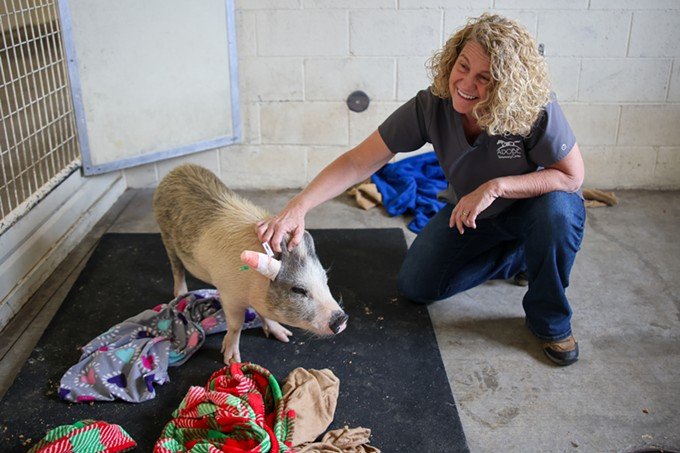isr. Kristin Staten remembers exactly when she decided she wanted to become a large animal veterinarian.
“I remember when I was nine years old and my pony (Brandy) was really sick,” she says, “the vet drove up to my house, treated my horse, and drove away an hour later, my horse was cured. I said to my mom, ‘Is he a wizard?’ He took my horse and brought him back to perfection within an hour, even though I thought he was going to die.”
Now, after 25 years in the business, she is the owner of Adobe Veterinary Center and Pet Resort, located on just under four acres at 8300 E. Tanque Verde Road. She and her team of 10 other female veterinarians treat small animals, large animals and horses, each with their own therapeutic specialization.
Veterinary clinics are in many ways similar to medical clinics: appointments, waiting rooms, exam rooms, stethoscopes, and all the other equipment that helps doctors understand the illnesses of the patients they see. The difference is the patients.
One day, a friendly standard poodle came in to sniff and pet the waiting room. On the way out, the medium-sized dog relieved itself on the tile floor. “Don’t worry, this happens all the time,” said a staff member as he came out with paper towels and cleaner. An inquisitive young Nubian goat was held by its owner while he paid the bill. All of this is part of the daily routine of the front desk.
Deeper inside, it’s a different story. The day is never the same and starts early in the morning: the first appointments are at 8am, but animals for surgery arrive at 7.30am.
At 9 a.m., Oakley, a young Nubian goat, was fast asleep on the exam table as Dr. Megan Marner, with the help of veterinary technician Paulina Garcia, removed the splints from Oakley’s hind legs.

(Hayley Davis/Staff)
In many ways, a veterinary clinic is a lot like a doctor’s office. What sets Adobe Veterinary Center apart is its patients.
“They play like crazy,” Marner said. “They’re really little kids and this (a broken leg) is not an uncommon injury. They heal really well from fractures.”
Marner looked at the X-rays of Oakley’s leg on an overhead monitor and determined that Oakley was doing well, but that it would take another three weeks for him to fully heal. She fitted him with a new splint, and when Oakley woke up, he was ready to go.
Marner is a rarity, but that’s not necessarily the case at Adobe’s clinic. She’s a large-animal veterinarian, a field few people aspire to enter. In fact, there are more than 700 counties in the country that don’t have a food animal (or large animal) veterinarian, Staten said.
“We currently have a shortage (of veterinarians) and unless we do some really big sustainability work, the shortage will continue,” she added.
The number of veterinarians is declining because the number of veterinarians retiring is outpacing the number of newcomers to the field, most of whom prefer to work with small animals.
“Fifty percent of veterinarians who work in large animal medicine leave within the first five years and move to small animal medicine or leave the profession altogether,” Staten says, “which means half of the few veterinarians we do hire are also leaving.”
Marner said like many veterinarians, she knew from an early age that she wanted to be a large animal veterinarian.
“I’ve always loved science and I’ve always loved animals,” she says, “and my love of large animals started when I started riding horses at a young age. It’s a very underserved area in veterinary medicine, especially the equine field; less than five percent of graduates go on to this area of medicine.”
To encourage students to enter the field, Staten has opened his practice to students so they can gain real-world experience. The practice accepts interns, and last January, along with two other veterinary practices, ran a week-long work experience for students from various veterinary schools across the country. Staten says it’s a way to show students how interesting and rewarding the field can be.
“We want students to be involved in large animal medicine,” she says, “and we want them to be interested in it. We’re interested, and if we can get students interested in it, then they have a much better chance of progressing in veterinary medicine.”
The back of the clinic houses larger animals that need to stay overnight or simply come in for a check-up. It looks like a big garage, with a tall door and a concrete floor. On this day, four pot-bellied pigs from Ironwood Pig Sanctuary were being treated. Staten sneaked into the enclosure of a pig named Mulligan and scratched his head. Mulligan had come in to be neutered, a procedure performed by a veterinary student.
Horses, cows, sheep, and pigs are all treated in the space, so in addition to Oakley the goat, Marner also met Bowtie the horse. Marner gave Bowtie vaccinations and examined his teeth, which he didn’t seem to care for very much. His teeth looked good, but Marner had developed sharp points, a common problem in horses, so he had to have them filed down. To do that, Marner and a veterinary technician placed Bowtie in a metal support structure, anesthetized him, and used a giant syringe and water to rinse his mouth.
Managing Oakley and the Bowtie was Backhaus’ day-to-day job, while Staten and Marner did nothing else.
“For those of us who are passionate about large animal medicine, I can’t imagine life being any better or doing it differently,” Staten said. “It’s the best job ever.”
“We all choose it because we love it,” Marner added.

